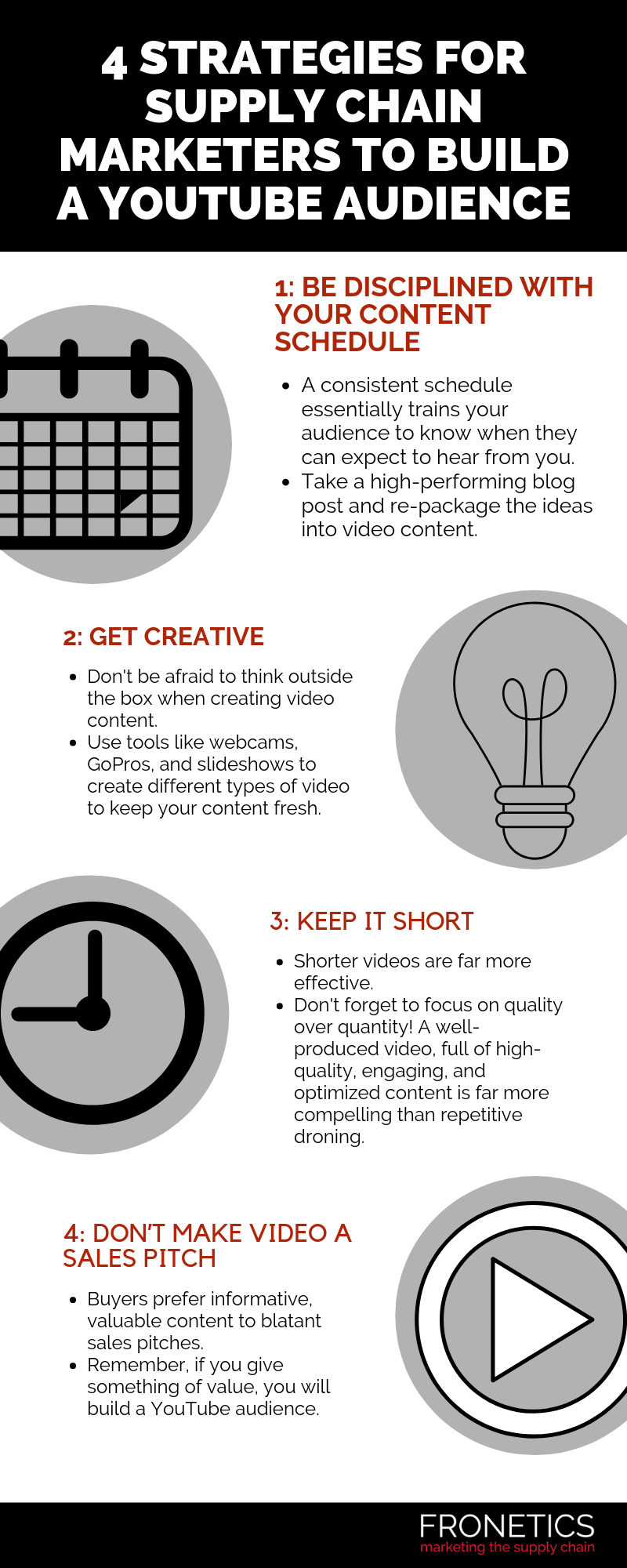
by Fronetics | Apr 16, 2019 | Blog, Content Marketing, Marketing, SEO, Video Marketing
With the growing popularity of video, it’s harder for video posts to rank in search results. Here’s what marketers need to know about SEO and video posts.
Highlights:
- When choosing your video hosting platform, it’s important to consider the reasons why you want your videos to rank, such as lead generation or brand awareness.
- Spend time crafting an engaging video title and description and make sure to use keywords audiences are actually searching for.
- Don’t solely rely on optimizing your video to receive placement on search engines. It’s just as important that the rest of the page is optimized for SEO.
Video transcript:
I’m Ulrika Gerth, and I’m the Content Writer and Strategist at Fronetics. Today I’m going to talk about what you need to know about SEO and video posts.
So video SEO is simply optimizing your video to be indexed and rank on the search engine results pages, like Google.
In the last few years, video marketing has become more and more popular among businesses and it’s easy to see why. It’s cost effective and easy to produce. But with the explosion of video, it’s also become much harder to get ranked on universal search results.
Here are a few ways to optimize your videos.
1. Pick the best platform.
When choosing your video hosting platform, you need to consider the reasons why you want your videos to rank. Are you optimizing your video to gain traffic and generate leads? Or are you more interested in thought leadership and brand awareness?
2. Make the video engaging.
The video thumbnail is what searchers will see when your video is indexed, and therefore it plays an important role in whether they will click on your video.
3. Pay attention to the title and description of your video.
Just like they do for a blog post, the title and description play a role in ranking videos. Spend time crafting an engaging video title and description. Make sure you do keyword research so you use keywords people are actually searching for.
4. Ensure the rest of your page is relevant to the video and optimized for SEO.
You can’t rely only on optimizing your video to receive placement on search engines. It’s just as important that the rest of the page is optimized for SEO, or the search engines won’t bother to crawl it in the first place.
For more information, visit fronetics.com.
Related posts:


by Fronetics | Apr 11, 2019 | Blog, Content Marketing, Current Events, Logistics, Marketing, Social Media, Supply Chain
Content marketing is no longer optional. It’s essential in creating brand awareness, educating audiences, and building credibility. Here’s a look at the biggest digital marketing trends for 2019.
Highlights:
- The content marketing industry is expected to be worth more than $400 billion by 2021.
- Video is currently the most popular form of content being consumed online today.
- Peers and colleagues are the third most influential source of information for B2B purchasing, right behind online searches and your website.
A recent article by Forbes on content marketing notes: “As recently as a few years ago, marketers handled content mostly as a side project. It was more of a bonus than an essential role — something you did when you had time because it took a backseat to more traditional marketing projects and responsibilities. That’s changed.”
Boy, has that changed. The content marketing industry is expected to be worth more than $400 billion by 2021.
[bctt tweet=”The content marketing industry is expected to be worth more than $400 billion by 2021.” username=”Fronetics”]
The 2018 report from the Content Marketing Institute shows just how prevalent digital and content marketing is, and how essential it has become to creating brand awareness, educating your audience, and building credibility and trust with your customers.
Supply chain & logistics marketers: Trends to watch
So, where is content marketing headed in 2019? Marketing budgets are still on the rise, and supply chain and logistics companies are increasingly seeing the value in moving to an inbound marketing strategy driven by original content.
These are the six notable trends to consider when planning your 2019 content marketing strategy.
1. Video
Video is currently the most popular form of content being consumed online today, and video marketing will continue to have substantial value in 2019.
Smart supply chain marketers should start the new year by developing a visual storytelling strategy that offers consistent delivery of valuable content.
What’s your best bet? Be helpful and teach your audience something worthwhile to them.
2. Chatbots
The rise of chatbots – automated computer programs that simulate human conversation in messaging apps – is expected to continue in 2019. Business Insider recently reported that the number of people on messaging apps surpassed the number of users on social networks!
Chatbots are just one of the ways artificial intelligence will shape the content marketing landscape in 2019, but their ability to drastically increase customer engagement puts them on the short list for a major trend to watch in the coming year.
3. Voice search
Voice search is becoming an increasingly prevalent means of attaining information. Statistics vary, but it’s expected that anywhere between 30-50% of all searches will be voice searches by 2020. A recent report by NPR and Edison Research found that the rise of smart speakers is substantially changing consumer routines and purchasing behavior.
A good content marketing strategy for 2019 should consider how your customers might use voice search in your industry, and what you can do to maximize your content’s ability to respond.
4. Long-form content
I love this one, because it harkens back to humble beginnings of content marketing and the desire to put informative, quality content in front of a targeted interested audience.
Long form content – white papers, case studies, and lengthier blog posts e.g. – will have a resurgence of renewed appreciation in 2019. Why? Because many industries, including supply chain and logistics industries, are saturated with tons of mediocre short form content. People are increasingly looking to weed through it all for substantial quality posts from trusted sources. In addition, search engines will favor longer posts in results rankings.
Cheers to 2019 being the year of quality over quantity!
5. Brand ambassadors
We wrote about brand ambassadors as we headed into 2018, but they are worth mentioning again as we look forward to 2019. Brand ambassadors are employees that influence the B2B buying decisions of others, and they are an often-overlooked resource with more traditional marketing tactics.
Peers and colleagues are the third most influential source of information for business to business (B2B) purchasing, right behind online searches and your website! And there’s nothing more credible than a friend who speaks highly of their company’s product or service.
Definitely consider how you can help make brand ambassadors out of your employees in 2019.
6. Market Influencers
The final trend to watch in 2019 is influencer marketing, a form of marketing which focuses on influential people rather than the market as a whole.
Basically, marketers identify individuals who might have influence over potential buyers and create marketing campaigns and activities around these influencers. In many ways, this works similarly to a brand ambassador, where a single person influences their network of friends; in this case, however, the market influencer has a large network and a lot of “friends” who listen.
Influencer marketing will be a huge trend in marketing for 2019, and it would be worth considering who might be an influencer in your industry in the coming year and what your company might do reach them.
So, there you have it. As we head into 2019, these are the trends to watch and plan for in content marketing space.
The B2B buying climate is growing longer and more complex, and content marketing is so effective throughout the entire sales cycle if it’s done well. The end of the year is a great time to revisit your marketing strategy and make any necessary changes for the coming year.
This post originally appeared on EBN Online.
Related posts:

by Fronetics | Apr 9, 2019 | Blog, Content Marketing, Marketing, Social Media, Video Marketing
If you’re trying to build a YouTube audience, you’ll need equal parts strategy, creativity, concision, and valuable subject matter.
Highlights:
- Strategy and creativity are top priorities.
- Keep content short and sweet for maximum impact.
- Offer value to your audience rather than a sales pitch.
An increasing percentage of search traffic is perusing YouTube for information, advice, and education. That makes the platform ideal for getting in front of prospects looking for products and services like yours.
But I’ve seen a lot of B2B marketers getting YouTube wrong. The good news is that the problem is usually that they’re trying too hard — and not in the right ways.
To effectively build a YouTube audience that will eventually become leads and, hopefully, customers, you need to be distributing video content that showcases your organization’s expertise in an approachable way. Here are some simple rules for how to go about that (without barking up the wrong tree).

(Made with Canva)
4 ways to build a YouTube audience
1) Be disciplined about your content schedule.
When it comes to publishing content on social media, when you post is nearly as important as whatyou post. YouTube is no different. Creating and sticking to a consistent schedule for posting new content essentially trains your audience and lets them know when they can expect to hear more from you.
Creating video content consistently doesn’t need to feel like reinventing the wheel. First off, videos should be part of your content calendar in the same way as blog posts, case studies, and other forms of content. You don’t need to create brand new material for each video. Take a high-performing blog post and re-package the ideas into video content.
2) Get creative.
Creativity for B2B companies is all about striking the right balance between entertaining presentation and informative, high-quality content. Think about approaching the information you want to convey in a different way. Can you use a different medium (like animation) or interview two subject-matter experts together if your one-on-one interviews are feeling stale?
There are plenty of technologies available today that will help you create exciting, engaging video content relatively cheaply. Or you could always consider outsourcing your videography.
3) Keep it short.
While we’ve seen recent growth in long-form YouTube content, for most B2B marketing purposes, shorter videos are far more effective. Of course, this is good news in that producing shorter videos can be less time-consuming and costly. But I cannot emphasize enough the importance of quality over quantity here.
[bctt tweet=”A 1- to 2-minute video of high-quality, well-edited content will get far more engagement (and be more successful in helping you build a YouTube audience) than 15 minutes of lecturing or poorly executed, complex animation.” username=”Fronetics”]
A 1- to 2-minute video of high-quality, well-edited content will get far more engagement (and be more successful in helping you build a YouTube audience) than 15 minutes of lecturing or poorly executed, complex animation. If you have a lot of footage about a certain subject, consider releasing a series of shorter videos.
4) Don’t make video a sales pitch.
Content marketing is inbound marketing, and video is no different. Countless studies have shown that increasingly buyers prefer informative, valuable content to blatant sales pitches.
This doesn’t mean that your content shouldn’t be branded, but it does mean that your focus in creation and execution needs to be what you can offer your audience, rather than you’re asking from them.
Use your video content to address specific concerns or answer questions that are relevant to your target audience. It’s simple: if you give something of value, you will build a YouTube audience that could eventually become your leads and customers.
What have you been doing to build a YouTube audience?
Related posts:


by Fronetics | Apr 4, 2019 | Blog, Content Marketing, Marketing
The best way to come up with creative and engaging content is to think outside the box and sometimes, take risks. Here are 4 rules to break to produce truly creative content.
Highlights:
- Throw out the template approach to content and start thinking about what makes you stand out.
- Don’t be afraid to showcase what you do best through different avenues, like customer or vendor testimonials.
- When you’re committed to curiosity, you naturally become a learning organization and this learning leads to more creative content.
Video transcript:
I’m Elizabeth Hines, and I’m the Creative Director at Fronetics, and today we’re talking about for more creative content, you have to break these four rules.
With over 4 million blog posts published every day, you have to be really creative with your content in order to drive traffic and win over prospects and leads.
So in order to do so, you’re going to have to break these four rules.
1. Mirror competitors
If you’re in this certain industry, then you have to cover these certain topics. You might think because your competitors are covering this certain topic or that certain topic, you should be covering it as well. Not so. You should be covering the topics that are unique to your business, that your company offers expertise in and the ways you stand out from your competitors.
2. Marketing mindset
While your marketing team has a great idea of what is going on in your, some of the best stories and the best blog content comes from your other teams. Maybe your sales team, sometimes your customers or your vendors have a really good prospective or a really good story to tell. And some of the most creative content comes from those unique prospectives.
3. Keep it obvious
It can be really tempting to do a quick brainstorm, come up with a couple good ideas, things that are obvious and things that stand out about your company. But you’re going to get much more creative content if you dig a little deeper. For example, if your first instinct is to talk about self-driving vehicles, a very popular topic right now, can you offer a new perspective on that topic? Can you talk specifically about the sensors that are involved in that technology? Can you talk about government regulations of that technology? What new perspective can you offer to that often talked about conversation?
4. Repeat success
Now this is a little bit controversial because I do encourage you to look at what’s been successful in the past and try to build on that and try to repeat that. But you should also be taking some risks when you’re developing your content calendar. Build in a healthy mix of what’s worked for you in the past, what resonates with your target audience. Then something new, something different, something totally out of left field, because you need to keep experimenting. You need to keep trying new things because your audience is going to evolve and your content should evolve creatively as well.
For more information, visit our website at fronetics.com.
Related posts:


by Fronetics | Apr 3, 2019 | Blog, Content Marketing, Manufacturing & Distribution, Marketing, Supply Chain
Here’s why manufacturing marketers should skip the sales pitch and create content that prioritizes the needs of their target audience.
Highlights:
- Research indicates that only about half of manufacturing marketers are prioritizing their audience’s needs when creating content.
- Inbound marketing (like content marketing) is more effective than outbound marketing for B2B businesses.
- A documented strategy will help you get started creating focused, quality content.
One statistic is sticking out to me in the Content Marketing Institute’s Manufacturing Content Marketing 2019: Benchmarks, Budgets, and Trends report. According to the research, half (51%) of manufacturing marketers reported that they always or frequently prioritize their sales/promotional message over their audience’s informational needs when creating content for content marketing purposes.
Let’s think about that for a second.
A preponderance of manufacturing content marketers are, unfortunately, missing the point.
We’ve written before about why inbound marketing, like content marketing, is more effective for the supply chain than more traditional outbound marketing techniques. And while it’s true that “the supply chain is increasingly seeing the value of moving to an inbound marketing strategy,” the CMI’s research suggests that it’s taking some marketers a long time.
Why you should be putting your audience’s informational needs first
Why should you be emphasizing your audience’s informational needs over your promotional goals when creating content?
[bctt tweet=”One of the basic premises of content marketing is the recognition that, increasingly, your customers want much more from you than your product.” username=”Fronetics”]
The short answer is: because your audience prefers it. One of the basic premises of content marketing is the recognition that, increasingly, your customers want much more from you than your product. For manufacturing marketers, this means that customers want value separate from and outside of the sales funnel.
Enter content marketing. Creating effective marketing content relies on accepting that your business has much more to offer than its primary products and services. In fact, your most valuable commodity, as we’ve often said before, isn’t any material or service — it’s the knowledge, expertise, and informed, unique perspectives you have to offer.
Strategize to put customers first
To successfully adjust your content marketing efforts to put your customers’ informational needs first, the first step is having a well-defined, measurable strategy — and documenting it. This means defining precisely who you’re trying to reach and developing a complete target buyer persona(s).
Once you’ve defined exactly who you’re trying to reach, it’s time to identify the unique questions, needs, and challenges this target buyer faces. Chances are, your business has not only the products to meet those needs, but also the information to answer question and offer valuable insights.
One of the benefits of a documented strategy, with clearly stated objectives, is that it allows you to set up metrics and evaluate your successes and shortfalls. This is where you can start listening to your target buyers. You can even solicit responses from them via email and social media that will allow you to target and hone your efforts in the future.
Meeting manufacturing marketers’ challenges
The CMI’s research reinforces the fact that manufacturing marketers face unique challenges. The top reported challenge was “creating content that appeals to multi-level roles within the target audience.”
According to Achinta Mitra, founder of Tiecas, an industrial marketing consultancy, “Buying decisions are made by a committee and very rarely, if ever, by an individual. Some of these stakeholders may never interact with your content or visit your site.”
Essentially, there are various types of buyers with various needs — meaning their content needs are different. Mitra advises bringing “subject matter experts to the forefront, and letting marketing do the heavy lifting in the background.” He bases his advice on the belief that “one engineer to another is a powerful concept for earning trust, gaining credibility, and winning the mindshare of engineers and industrial professionals.”
If you’re thinking beyond downloads when creating content, and truly prioritizing quality information, your content will function broadly throughout the complex manufacturing buyer’s journey.
Related posts:

by Fronetics | Apr 2, 2019 | Blog, Content Marketing, Logistics, Marketing, Supply Chain
Follow these supply chain and logistics blogs to keep up with the latest industry news and happenings.
Highlights:
- These industry blogs are rich with the latest news, insights, and trends.
- Blogs cover a variety of topics, including research and strategy, and feature insights from some of the top thought leaders in the industry.
One of the best ways to keep pace with the latest happenings in the supply chain industry is to follow the right blogs. There’s some great information available out there, and we’ve put together this list of our 10 favorite sources.
These blogs are rich with industry news, insights, and trends. They cover a variety of topics, including research and strategy, and feature insights from some of the top thought leaders in the industry.
10 must-follow supply chain and logistics blogs (in no particular order)
1) Supply Chain 24/7
The Supply Chain 24/7 blog is a top business resource for Transportation, Distribution, Logistics and Supply Chain professionals. Read this blog.
2) Women In Trucking
These two blogs focus on various issues facing women in the trucking industry. WIT President Ellen Voie writes about topics in employment, achievement, and driving change in the industry. The Women In Trucking blog features posts by truckers, mostly industry veteran Sandy Long, about everyday concerns and experiences facing female drivers and their families. Read this blog.
3) Hollingsworth
Using best-in-class warehouse management technology, Hollingsworth offers complete, real-time visibility of the supply chain. The blog focuses on topics ranging from complex order fulfillment strategies to best practices for optimizing supply chain management. Industry tips, new technologies, and the latest strategies are just some of the topics covered in the posts. Read this blog.
4) Supply Chain Brain
This portal for supply chain executives features original and aggregated content touching on multiple industries. Read this blog.
5) Supply Chain Shaman
Lora Cecere’s blog focuses on “the use of enterprise applications to drive supply chain excellence.” Read this blog.
6) Supply Chain Matters
The blog of Bob Ferrari offers his expertise on all aspects of supply chain business processes and supporting information technology. Read this blog.
7) Supply Chain Management Review
This vast website includes trending articles on supply chain and logistics strategies developments, many written by university-level professors. Read this blog.
8) Supply Chain Digital
Supply Chain Digital is a forward-thinking digital community aimed at providing procurement & supply chain professionals with industry-leading news, analysis, features, and reports about the world’s biggest supply chains. Read this blog.
9) Logistics Viewpoint
This blog features think pieces from three leading supply chain and logistics analysts with the mission to provide clear and concise analyses of logistics trends, technologies, and services. Read this blog.
10) EBN Online
This blog features top industry leaders publishing on topics including electronics manufacturing, global supply chain, and management logistics. Read this blog. (P.S. Read our CEO Frank Cavallaro’s blog here.)
What supply chain and logistics blogs are you following lately?
Related posts:











